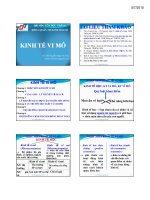- Trang chủ >>
- Đại cương >>
- Kinh tế vĩ mô
Unemployment (KINH tế vĩ mô 1)
Bạn đang xem bản rút gọn của tài liệu. Xem và tải ngay bản đầy đủ của tài liệu tại đây (412.68 KB, 18 trang )
Chapter 5 Unemployment
Content
I Definitions and computing method
II Unemployment classification
III Impacts of unemployment on the economy
IV Solutions to reduce unemployment
I Definitions and computing method
Definitions
Employed is the People who work
Unemployed is the People who are Not employed
but Want to work and are Looking for a job
Labor force = Number of employed + Number of
unemployed
Not in the labor force (non-labor force): Not
employed Not unemployed. It includes children,
elders, students, disable…
Adult population is the proportion of population that
is within working – age (includes labor force and a
part of non – labor force)
I Definitions and computing method
I Definitions and computing method
Computing method
Unemployment rate: Percentage of labor
force that is unemployed
Numberof unemployed
Unemployme
nt rate
100
Labor force
Labor-force participation rate: Percentage
of adult population that is in the labor force
Labor force
Labor- forceparticipat
ionrate
100
Adultpopulation
5
I Definitions and computing method
Computing method
Math problems
1. Population of Vietnam is 90 million people. The
employed is 43 million people, the unemployed is 1.5
million people. There are 4.5 million people in
working – age but out of labor force. Calculate
unemployment rate, labor participation rate?
2. FTU city has adult population of 100 thousand people.
Labor force participation is 90% and the employed
are 70 thousand people. Calculate unemployment
rate?
3. The employed is greater than the unemployed 70
million people. Adult population is 90 million people.
Labor participation rate is 25 time higher than
unemployment rate. Calculate unemployment rate?
II Unemployment classification
There are two fundamental types of unemployment
Natural rate of unemployment
Normal rate of unemployment that exists even at
the equilibrium of labor market by objective reasons
Around which the unemployment rate fluctuates
Existence in the long run
Cyclical unemployment
Deviation of actual unemployment from its natural
rate
Non-existence in the long run when the economy
adjusts itself
Unemployment rate of the US since 1960
This graph uses annual data on the U.S. unemployment rate to show the
percentage of the labor force without a job. The natural rate of unemployment is the
normal level of unemployment around which the unemployment rate fluctuates
II Unemployment classification
1 Natural rate of unemployment
There are four categories of natural unemployment
+ Frictional unemployment: Results because it takes time
for workers to search for the jobs that best suit their tastes
and skills
E.g. The graduate who just leave university is finding a job
+ Structural unemployment: occurs when a labor market
is unable to provide jobs for everyone who wants one
because there is a mismatch between the skills of the
unemployed workers and the skills needed for the available
jobs
E.g. Farmers who were reclaimed land try to be workers
+ Seasonal unemployment: occurs at seasonal jobs which
require working in certain moments of a year
E.g. Employee in water park in winter
II Unemployment classification
1 Natural rate of unemployment
+ Classical unemployment: occurs when real
wages for a job are set above the marketclearing level, causing the number of job-seekers to
exceed the number of vacancies.
E.g. Unskilled worker who only graduates from high
school
Reasons for classical unemployment
Minimum wage law
Efficiency wages
Labor unions
II Unemployment classification
1 Natural rate of unemployment
+ Classical unemployment
II Unemployment classification
2 Cyclical rate of unemployment
Cyclical,
deficient-demand,
or Keynesian unemployment, occurs when
there is not enough aggregate demand in the
economy to provide jobs for everyone who
wants to work. Demand for most goods and
services falls, less production is needed and
consequently fewer workers are needed,
wages are sticky and do not fall to meet the
equilibrium level, and mass unemployment
results
II Unemployment classification
2 Cyclical rate of unemployment
Sticky
wage
II Unemployment classification
All types of unemployment illustrated in labor
market model
At W*/P: AB cyclical unemployment, BC natural
unemployment (without classical unemployment)
At W1/P: DE cyclical unemployment, EG natural
unemployment includes EF classical
III Impacts of unemployment on the
economy
1 Negative impacts
Waste of labors not used to produce goods and
services → output decline – supply side (Okun’s law)
Demand for goods and services declines →
production decrease – demand side
Burden of society in supporting unemployed →
ineffective resource allocation
Unemployment time mitigates labor’s skill →
productivity decrease
Unstable mentality of individuals who can not find a
job and related person → unstable for the whole
society
III Impacts of unemployment on the
economy
2 Positive impact
Job seekers have enough time to find
appropriate job
Labors who just lost their jobs have time to
relax
Someone has time to acquire necessary
skills to do a new job
IV Solutions to reduce unemployment
1Government – run employment agencies:
reduce time for unemployed to find jobs
2 Public training programs: equip quickly
necessary skill for unemployed to find jobs
3 Labor movement facilitation: reduce frictional
unemployment
4 Income tax reduction: incentivize more
economic activities
5 Unemployment insurance cut: encourage
unemployed to find jobs quickly
6 Demand side stimulus: promote manufacture,
thereby creating more jobs
Key concepts
Unemployment
Labor force
Unemployment rate, labor-force
participation rate
Natural rate of unemployment
Cyclical unemployment
Frictional unemployment, structural
unemployment, seasonal unemployment,
classical unemployment









